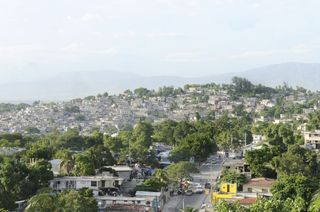How to Make a Zombie (Seriously)

The slouching, flesh-eating zombie has become one of the most in-vogue creatures in current TV and movie offerings, appearing in films like "World War Z" and in the AMC series "The Walking Dead."
Most rational people scoff at the suggestion that zombies are real, but a number of respected medical experts and academic journals have presented evidence that zombies are, in fact, real.
To understand the zombie phenomenon and its Haitian roots, an appreciation of the practice of vodou (sometimes spelled voodoo or vodun) is needed. A religion based in West Africa, voodou is still practiced in varying forms throughout the Caribbean, Brazil, the American South and other places with a strong African heritage. [Zombie Facts: Real and Imagined (Infographic)]
Vodou spirituality has a rich tradition of fetish objects, including the so-called "voodoo doll." Practitioners of vodou also place a particular importance on herbal remedies and other concoctions that may include animal parts, such as bones and hair, dried plants, shells, minerals or other ingredients.
Toads, worms and human remains
Vodou priests known as bokor create a white, powdery compound called coupe poudre, according to numerous reports. The ingredients in this powder allegedly can turn a person into a zombie. In the 1980s, Harvard ethnobotanist Wade Davis traveled to Haiti to investigate zombies and "zombie powder."

Though different bokor used different ingredients in their powders, Davis found that "there are five constant animal ingredients: burned and ground-up human remains [usually bone], a small tree frog, a polychaete [segmented] worm, a large New World toad, and one or more species of pufferfish. The most potent ingredients are the pufferfish, which contain deadly nerve toxins known as tetrodotoxin," Davis wrote in Harper's Magazine.
Sign up for the Live Science daily newsletter now
Get the world’s most fascinating discoveries delivered straight to your inbox.
Some in the scientific community have criticized Davis' research — his investigation was published in 1983 in the Journal of Ethnopharmacology — but his identification of tetrodotoxin as the active ingredient in zombie powder has considerable scientific merit.
Euphoria, then death
Several animals contain tetrodotoxin in their tissues; the liver, eyes and ovaries of the pufferfish (genus Takifugu) have especially high amounts of the lethal nerve toxin. Though regarded as a delicacy in Japan, the fish and some of its organs (especially the liver) are banned as food items in many places because of the dangers.
In small amounts, tetrodotoxin causes numbness, tingling and a not-unpleasant sensation of floating — even euphoria — according to reports from brave gourmands who have sampled carefully prepared pufferfish. High levels of the toxin, however, can cause death within minutes due to respiratory failure.
But at sublethal doses, the toxin can leave a victim in a state of suspended animation: Breathing is subdued and barely perceptible by observers, the heart rate is near zero, but the person remains conscious and aware (though unable to speak). [Zombie Animals: 5 Real-Life Cases of Body-Snatching]
Zombie slavery
This toxin, then, may form the basis of the zombie phenomenon. According to Davis and other observers, a person who is exposed to a certain amount of zombie powder containing tetrodotoxin can slip into a vegetative state resembling death. Shortly after the person is buried, their body is exhumed by a bokor.
Though the exhumed zombie usually suffers from apoxia (oxygen deprivation) caused by breathing the limited amount of air inside a coffin, the bokor wields control over the person by continually administering a second drug, a psychoactive compound derived from the jimson weed (Datura stramonium). This second drug causes delirium and disorientation, rendering the person incapable of normal functioning.
The British medical journal The Lancet published three accounts of "zombification" in 1997. In one case, a woman who was presumed dead and was buried in a family tomb reappeared three years later — she was positively identified by several family members and townspeople. "After a local court authorized the opening of her tomb, which was full of stones, her parents were undecided whether to take her home, and she was admitted to the psychiatric hospital in Port-au-Prince," the authors wrote.
Because death certificates and other official niceties are rare in rural Haiti, and because burial generally occurs within a day of death, "it is not implausible for a retrieved person to be alive," the authors added. "The use of Datura stramonium to revive them, and its possible repeated administration during the period of zombie slavery, could produce a state of extreme psychological passivity."
The legal status of zombies
A well-known report of a zombie comes from the pages of ChemMatters, the publication of the American Chemical Society. In 1962, a man named Clairvius Narcisse was admitted to Albert Schweitzer Hospital in Port-au-Prince with severe respiratory problems. After slipping into a coma, Narcisse was later declared dead by two hospital doctors and was buried shortly thereafter.
Eighteen years later, in 1980, a man shuffled up to Angelina Narcisse in a village marketplace and identified himself as her brother. He related a story of being buried alive, dug up and enslaved on a distant sugar plantation. Doctors who examined Narcisse — and dozens of villagers and family members — positively identified him as the man who was buried in 1962.
But if you're tempted to make a zombie slave of your own, be aware that the zombie phenomenon is considered so real in Haiti that it's specifically outlawed.
Article 249 of the Haitian penal code states, "It shall also be qualified as attempted murder the employment which may be made against any person [using] substances which, without causing actual death, produce a lethargic coma more or less prolonged. If, after the person had been buried, the act shall be considered murder no matter what result follows."
Follow Marc Lallanilla on Twitter and Google+. Follow us @livescience, Facebook & Google+. Original article on LiveScience.

